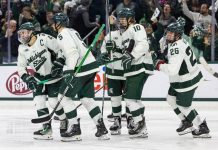We’re onto the quarterfinals in every conference except the Big Ten. Below are the PairWise Rankings through games of March 6, and as you can see, there are a few changes from last week, and the projected cut line has moved.
1. North Dakota*
2. Quinnipiac*
3. St. Cloud State
4. Providence*
5. Boston College
6t. Denver
6t. Yale
8t. Michigan*
8t. Boston University
10. Notre Dame
11. Harvard
12. Massachusetts-Lowell
13. Minnesota-Duluth
14. Michigan Tech*
15. Omaha
— projected cut line —
16. Cornell
— average position for outsider to make the tournament
17t. Minnesota
17t. Penn State
19. Northeastern
20. Clarkson
21. Robert Morris*
22t. Rensselaer
22t. Miami
22t. Minnesota State
25. St. Lawrence
— lowest any team has been ranked and still qualified —
26. Bowling Green
27. Dartmouth
28. Air Force
29t. Holy Cross
29t. Union
31. Bemidji State
32. Ohio State
33. Northern Michigan
34. Ferris State
35t. Mercyhurst
35t. Vermont
37. Merrimack
38t. New Hampshire
38t. Western Michigan
40t. RIT
40t. Wisconsin
42t. Michigan State
42t. Colgate
44. Lake Superior
45t. Connecticut
45t. Army
47. Bentley
48. Brown
49t. Sacred Heart
49t. Massachusetts
51. Canisius
52. Alaska-Anchorage
53t. Colorado College
53t. Alaska
55. Maine
56. Princeton
57. Alabama-Huntsville
58. Niagara
59. Arizona State
60. American International
As Michigan Tech moved up in the rankings, the cut line is dropped to 15. Minnesota is the top team in the B1G, but I deal with the PairWise, not conference standings. For those, check out Jayson Moy’s Bracketology. Since Michigan is above the cut line, I assume they will win the conference autobid. As Minnesota is the host in St. Paul and it sets up a potential North Dakota vs. Minnesota game in the first round, there are going to be strong opinions. However, for the purposes of this writing, Minnesota — or any team below the cut line — winning a conference autobid is considered an upset.
With that out of the way, onto the historical analysis.
In the 13 previous seasons:
• The team ranked No. 1 overall as the quarterfinals began finished No. 1 overall seven times and never lower than No. 3 overall.
• The No. 2 overall team finished No. 1 five times and also has never finished lower than No. 3 overall.
• The No. 3 team finished first only once (Boston College in 2005) and in 10 seasons was a No. 1 regional seed.
• The No. 4 overall team has remained in the top four in only five seasons, and never higher than third.
• Seven times, the overall No. 5 team has moved into the top four.
Overall, the top four will remain in the top four 77 percent of the time. Put another way, the top three teams typically remain and the No. 4 and 5 teams trade places.
The worst performance by any of the top four came in 2012 when UMass-Lowell dropped from No. 3 overall all the way to No. 12 after being upset by Providence in the quarterfinals of the Hockey East tournament.
Conversely, the 2013 Notre Dame squad rose from No. 14 to finish No. 4 overall. 2012 is the only season two of the top four teams finished worse than fourth as Minnesota-Duluth joined UMass-Lowell in the exodus. No. 13 North Dakota leapt up the rankings after sweeping through the WCHA Final Five to finish fourth.
The top nine teams are statistically safe. The 2005 Dartmouth Big Green squad is the only team to drop from No. 10 entirely out of the tournament after losing to Vermont in the ECAC Hockey playoffs. Teams that are ranked 1-12 now make the tournament a whopping 94 percent of the time. Overall, 90 percent of teams above the projected cut line remain above the cut line. Only the 2010 Michigan Wolverines and 2013 Wisconsin Badgers have jumped from No. 20 or worse to land in the tournament. The bubble is getting smaller.
Looking at the schedule coming up, the opportunity still exists for teams like Clarkson and Miami to play their way in, but realistically, people should look to Cornell, Minnesota and Penn State to see a team move above that cut line.


